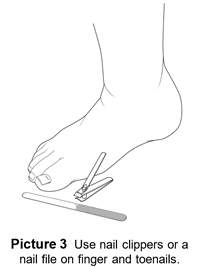Bathing Your Baby
![]()
You can bond with your baby while bathing them. Talking, singing, and playing during bath time will help them develop their language skills. Bathe them 3 to 4 times a week with mild soap to prevent skin rashes and chafing.
You Will Need
- Warm water
- Baby shampoo
- Comb and hair brush
- Dry towels
- Damp washcloth
- A shirt, gown, or sleeper
- A diaper
- Baby blanket
- Scent- and alcohol-free soap
Safety
It is important to follow these safety rules when bathing your baby:
- Keep the room warm so your baby does not get cold. Bathe your baby quickly to avoid chilling.
 Keep water around 100° Fahrenheit (F) or 37.8° Celsius (C). Test the water with a bath thermometer, your elbow, or your wrist (Picture 1). The water should feel warm, not hot.
Keep water around 100° Fahrenheit (F) or 37.8° Celsius (C). Test the water with a bath thermometer, your elbow, or your wrist (Picture 1). The water should feel warm, not hot.- Set water heaters at 120°F (48.9°C) to prevent burns.
- Keep one hand on your baby at all times.
- Never leave your baby alone in any amount of water.
Types of Baths
- Your baby’s umbilical cord will likely fall off 1 to 2 weeks after they are born. Give your baby sponge baths until the umbilical cord falls off. This can be done on a towel, blanket, changing table, or bath pad. Make a bath pad by putting a clean towel on top of a folded blanket. After the umbilical cord falls off or a circumcision heals, you can use a sink or baby tub.
- Do not use a bath chair. These can cause injury or death.
How to Bathe Your Baby
- Fill the sink or baby tub with no more than 3 inches of warm water. Test temperature of the water.
- Undress your baby. Place them on the pad, if giving a sponge bath, or in a basin of water.
- Before putting soap on a washcloth, gently clean your baby’s eyelids. Using a clean spot on the cloth, start at the inner corner of the eye and wash toward the ears.
- Then, wash your baby’s face with only water. Do not use soap on their face.
- Use clean water to wash the outer part of the ear. Do not use cotton swabs, like Q-tips®, inside your baby’s ears.

- Wet your baby’s head with water. Put mild soap or shampoo on the washcloth. Gently rub the washcloth over their head from front to back. Keep soap out of their eyes. Rinse their head with clean water and gently pat dry with the towel.
- While your baby is lying on the pad or in the basin, reach under them to lift their back and head up with your arm (Picture 2).
- Make a soapy lather on the washcloth or with your hands. Start at the neck and lather your baby’s entire body. Be sure to clean between fingers, toes, and skin folds.
- Use the soapy washcloth or your hands to clean the diaper area.
- Start at the front and move back to the buttocks.
- If your baby is not circumcised, do not pull back the foreskin to clean the penis.
- Rinse the soap off your baby with a clean, wet washcloth.
After the Bath
- Pat your baby dry with a clean towel.
- If you want, use lotion. Do not put lotion on your baby’s face.
- Brush and comb your baby’s hair.
- Clean their fingernails and toenails. Carefully clip the nails with baby scissors or clippers when needed (Picture 3). Do this by making short, little clips above the white nail line. This will help avoid cutting the nail too close. Or you may file the nails with a nail file. Keep your baby’s fingernails short so they do not scratch their face.
Scalp Care
Your baby’s scalp may look dry or scaly. This is called cradle cap. These things can help with cradle cap:

- Put a small amount of baby oil on their hair after shampooing. Leave it on until the next day.
- Brush your baby’s hair and scalp the next day to remove old skin, then shampoo your baby’s hair.
- Wash the brush and comb with soapy water, then rinse and dry.
If you have any questions, please ask your health care provider.
HH-IV-2 1/78, Revised 1/22 Copyright 1978, Nationwide Children's Hospital
